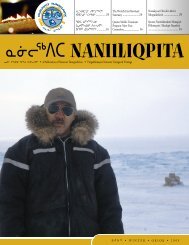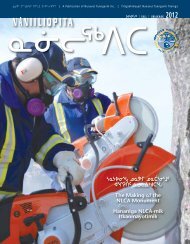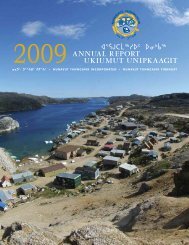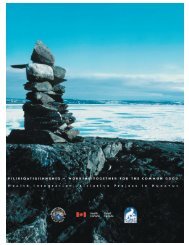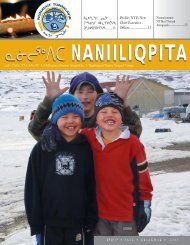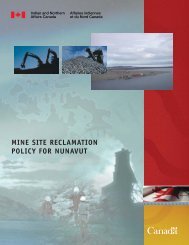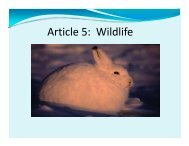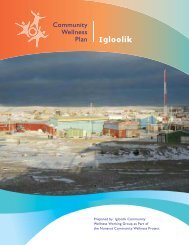Ensuring a Sustainable and Humane Seal Harvest - Nunavut ...
Ensuring a Sustainable and Humane Seal Harvest - Nunavut ...
Ensuring a Sustainable and Humane Seal Harvest - Nunavut ...
Create successful ePaper yourself
Turn your PDF publications into a flip-book with our unique Google optimized e-Paper software.
The Committee believes that in order to minimize the risk of disturbing the seals, aminimum distance between the observers <strong>and</strong> the animals should also be implemented. A1990 study of the impact of tourism on the behaviour of female harp seals <strong>and</strong> their pupsduring whelping found that “virtually all aspects of the behaviour of mothers <strong>and</strong> pups weresignificantly affected by the presence of tourists. Female attendance was significantlyreduced <strong>and</strong> those females that remained with their pups when tourists were present spentsignificantly more time alert <strong>and</strong> less time nursing their pups.” 48 Although the impact hasbeen described as short-lived, it is particularly worrisome given the harp seal’s short <strong>and</strong>intense nursing period (12 days).The Committee notes that observing the seal harvest has mostly served to acquireimages that have been used to campaign against the seal harvest. The Committee heardthat these images are often manipulated <strong>and</strong> misused. This would be contrary to theCanadian Association of Journalists Ethics Guidelines which states that “photojournalists[…] will not alter images so that they mislead the public” <strong>and</strong> that journalists “will explain inthe photo caption if a photograph has been staged.” In addition, the Committee was toldthat photographs <strong>and</strong> video footages are often taken without the authorization of theindividuals depicted despite a condition of the <strong>Seal</strong> Fishery Observer Licence that statesthat “as a matter of courtesy, it is recommended that photographs of fishers, identifiable asto a person, not be made without the express consent of the fisher involved.” 49 TheCommittee contends that this is not a “matter of courtesy”, but rather a legal matter asdemonstrated by the 1998 Supreme Court of Canada decision in Aubry v. EditionVice-Versa Inc. (better known as the Duclos case) 50 , which found that the right to privacy(in this case the right to one’s image infringed upon by the publication in an art magazine ofa photograph of a teenager taken in a public place) prevailed over freedom of expression.Observers taking photographs or video footage on the harvesting grounds should respectthese ethical guidelines. Consequently, the Committee believes that DFO shouldstrengthen the language of this condition of the observer’s licence.Since its inception, the practice of observing the seal harvest, although guaranteedby the Charter of Rights, has put dem<strong>and</strong>s on DFO’s human, material <strong>and</strong> financialresources. The Committee believes that the real cost of allowing the observation of theseal harvest should be reflected in the observation licence fees.484950of firearms. In Ottawa, a by-law (By-law no. 2002-344) prohibits the discharge of a firearm within 450 meters of anyplace of worship, public hall or school property.K. M. Kovacs <strong>and</strong> S. Innes, “The impact of tourism on harp seals (Phoca groenl<strong>and</strong>ica) in the Gulf of St. Lawrence,Canada”, Applied Animal Behaviour Science, Volume 26, Issues 1-2 , March 1990, Pages 15-26.<strong>Seal</strong> Fishery Observation Licences issued to members of the Committee on April 3, 2007.Aubry v. Éditions Vice-Versa inc., [1998] 1 S.C.R. 591.20




